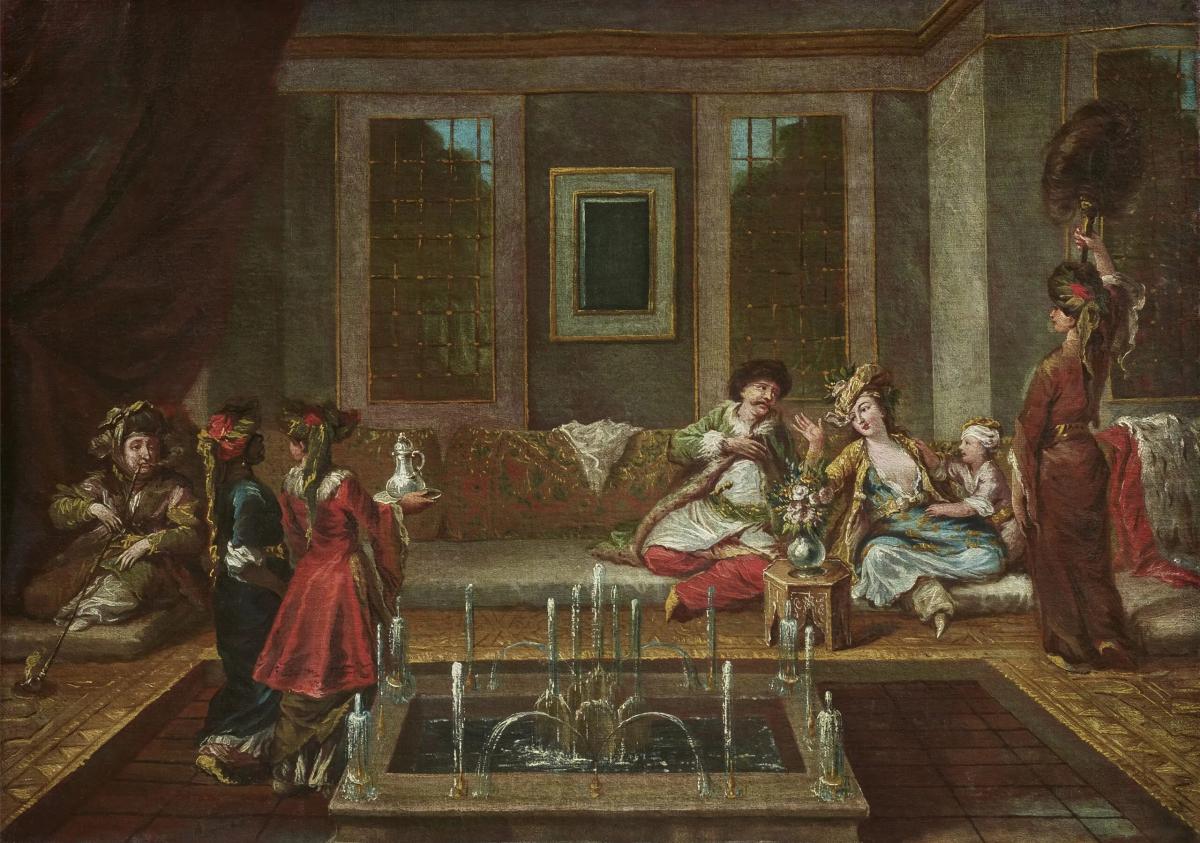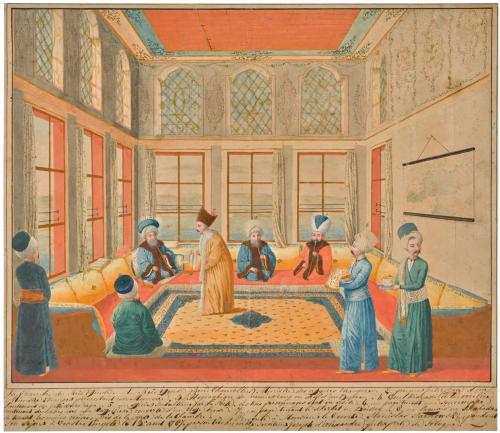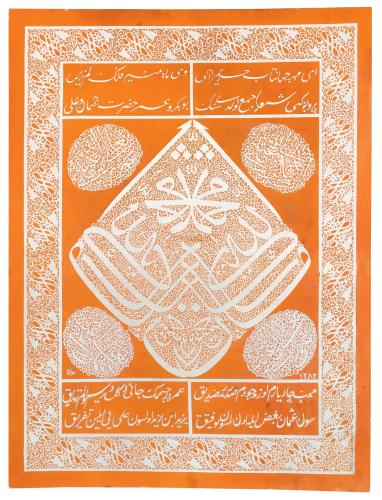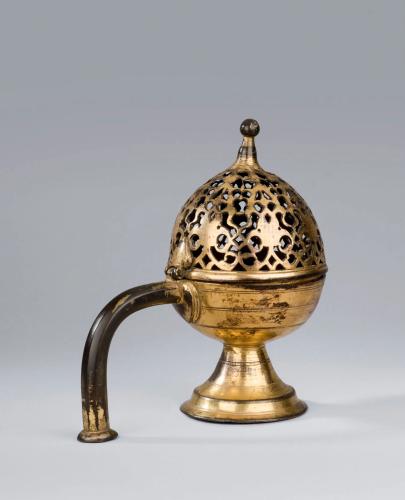

Price on application
This object is eligible for a Certificate of BADA Provenance
The BADA Standard
- Since 1918, BADA has been the leading association for the antiques and fine art trade
- Members are elected for their knowledge, integrity and quality of stock
- Our clients are protected by BADA’s code of conduct
- Our dealers’ membership is reviewed and renewed annually
- Bada.org is a non-profit site: clients deal directly with members and they pay no hidden fees
Armenian Interior – Attributed to Gianantonio Guardi (1699-1760)
Oil on Canvas.
Height: 44 cm.
Width: 62 cm
The present painting is a rare, early 18th century depiction of an Armenian gentleman in a harem interior, surrounded by ladies. An almost identical painting, after Jean-Baptiste Vanmour (d. 1737), painted by Gianantonio Guardi for Comte de Schulenbourg, titled ‘Interno Armeno’ (Armenian interior), with the same dimensions, in the Fondazione Giorgino Cini collection in Venice, is published in the exhibition catalogue Guardi – Quadri Turcheschi, 28 August – 21 November 1993, Fondazione Giorgino Cini, Istituto di Storia dell’Arte, Venice, p. 31.
Jean-Baptiste Vanmour’s painting with the same subject, now in a private collection, is published in Auguste Boppe, Les Peintres du Bosphore au XVIIIe Siècle, ACR Edition, Paris, 1989, p. 52. Please also see, Guardi – Quadri Turcheschi, 28 August – 21 November 1993, Fondazione Giorgino Cini, Istituto di Storia dell’Arte, Venice, p. 121 (This publication states that it is in the Emmanuel Boppe Collection, Geneva).
The gentleman wearing a black headgear, seated in the back, next to the seated lady on the right, has been identified as a ‘notable Armenian’ in the 1993 Guardi exhibition catalogue. Please see, Guardi – Quadri Turcheschi, 28 August – 21 November 1993, Fondazione Giorgino Cini, Istituto di Storia dell’Arte, Venice, p. 120.
Vanmour’s paintings, depicting the Dutch ambassador’s visits to the Topkapi Palace, allow us to identify the occupation of this ‘notable Armenian’. His black headgear is exactly the same as those worn by the Armenian interpreters (dragomans) accompanying the Dutch ambassador Cornelis Calkoen (1696-1764) in Vanmour’s The Feast Held in Honour of Ambassador Calkoen. For an illustration of this painting please see the exhibition catalogue, Lale Devrinin bir Görgü Tanığı Jean-Baptiste Vanmour, (Texts written by Eveline Sint Nicolaes et al), Koçbank, Istanbul, 2003, p. 193.
In the present painting, the interior decoration, the marble fountain and furniture in the harem indicate the wealth of the seated gentleman, possibly an Armenian interpreter. The fountain resembles the famous square marble fountain in the Topkapi Palace, located in the middle of the imperial pool called the Sofa-i Hümayun Havuzu. It is a rare, mid-18thcentury depiction of an Armenian interior, demonstrating the beauty, richness and colourfulness of the lives of the Istanbul elite.
Gianantonio Guardi (b. Vienna 1699 – d. Venice 1760)
He was born in Vienna into a family of nobility from Trentino. His father Domenico (born in 1678) was a Baroque painter. Gianantonio and his brothers Niccolò and Francesco (also painters), later inherited the family workshop after their father’s death in 1716. They probably all contributed as a team to some of the larger commissions later attributed to his brother Francesco Guardi. His sister Maria Cecilia married the pre-eminent Veneto-European painter of his epoch, Giovanni Battista Tiepolo. He may have received his artistic training in Vienna, where he is first recorded in 1719, but had established a workshop in Venice by 1730. Among his first important clients was the connoisseur and collector Johann Matthias von der Schulenburg, for whom Guardi created numerous paintings with an Orientalist theme.
He painted Turkish-inspired interiors as easel pictures for private decorations. Antonio Guardi trained his younger brothers Nicolò and Francesco in his workshop, the latter working closely with him as a figure painter before establishing himself as a vedutista in the late 1750s. A founder member of the Accademia Veneziana in 1756, the elder Guardi produced several works for churches in Venice, notably in the Church of the Angelo San Raffaele, as well as decorative cycles for palaces and villas in the city and the surrounding countryside. Francesco Casanova was among his pupils. He died in Venice in 1760.
Provenance:
Sold in Paris, Hotel George V, Ader – Tajan, October 25, 1994, no. 413.
Ex-Edmonde Charles-Roux (1920-2016) Collection
Ex-François Charles- Roux (1879-1961) Collection, Ambassador of France.
François Charles-Roux (1879-1961)
Charles-Roux, the son of Jules Charles-Roux, studied at the École libre des sciences politiques. This led to a diplomatic career in Paris, St. Petersburg, Constantinople, Cairo, London and Rome before being appointed Ambassador for France in Czechoslovakia in 1932. In May 1940, he succeeded Alexis Léger to the position of Secretary General of the French Foreign Ministry but left office the following October.
After World War II, he was a strong supporter of keeping the French colonial empire including the ultra group Présence française which fought for the maintenance of the French protectorate in Morocco. He was chairman of the Central Committee of the Ministry of Overseas France and President of the Suez Canal Company from 1948 to 1956. He also chaired the Catholic Relief. His work as a historian led to him being elected a member of the Academy of Moral and Political Science in 1934. François Charles-Roux married Sabine Gounelle in 1914. She was from a family of merchants in Marseille who owned the Villa Valmer. They had three children: the writer Edmonde Charles-Roux, socialite Cyprienne Charles-Roux, and priest Jean-Marie Charles-Roux. François Charles-Roux died in 1961.
Edmonde Charles-Roux (1920-2016)
Charles-Roux was a French writer. She was born in 1920 at Neuilly-sur-Seine, the daughter of Francois Charles-Roux, the former French ambassador to Czechoslovakia, a member of the Institut de France and the last chairman of the Suez Canal Company. Her paternal grandfather, Jules Charles-Roux, was a businessman and politician. Charles-Roux was a volunteer nurse in World War II, at first in a French Foreign Legion unit, the 11th infantry regiment abroad. She was wounded at Verdun while bringing aid to a legionnaire.
Then she joined the Resistance, again as a nurse. After the landings in Provence, she was attached to the 5th Armored Division, where she performed as a nurse but also as a divisional social assistant. She also served in the 1st Foreign Cavalry Regiment (1er REC) and the Mechanized Regiment of the Foreign Legion (RMLE).
Decorated with the Croix de Guerre, she was made Chevalier de la Legion d’Honneur in 1945, and received the distinction of Vivandière d’honneur from the RMLE at the hands of Louis-Antoine Gaultier, corps commander. In 1946, she joined the staff of a magazine being created, a women’s weekly: Elle, where she spent two years. From 1948, she worked for the French edition of Vogue, becoming the magazine’s editor-in-chief in 1954.
By combining ready-to-wear and pop art, she connected fashion with any other form of creativity. She left Vogue Paris in 1966, as the result of a conflict for wanting to place a black woman on the cover of the magazine. Three months later, in 1966, she wrote Oublier Palerme and obtained the Prix Goncourt; the novel was adapted to film as Dimenticare Palermo in 1990 by Francesco Rosi.
The same year that she won the Goncourt she met Gaston Defferre, the mayor of Marseille, and they married in 1973. Charles-Roux is also known for her photo stories on the lives of Defferre (L’Homme de Marseille, 2001), and of Coco Chanel (Chanel Time, 2004). She wrote the books of several of Roland Petit ballets, including Le Guépard and Nana. She became a member of the Académie Goncourt in 1983, and president in 2002. In 2008, she was part of the Commission headed by Hugues Gall and charged by Christine Albanel, Minister of Culture, with recommending a candidate for the post of Director of the French Academy in Rome, Villa Medici. In April 2010, she was awarded by French President Nicolas Sarkozy, with the rank of Commandeur de la Légion d’Honneur. Edmonde Charles-Roux died on 20 January 2016, in Marseille.
The BADA Standard
- Since 1918, BADA has been the leading association for the antiques and fine art trade
- Members are elected for their knowledge, integrity and quality of stock
- Our clients are protected by BADA’s code of conduct
- Our dealers’ membership is reviewed and renewed annually
- Bada.org is a non-profit site: clients deal directly with members and they pay no hidden fees




